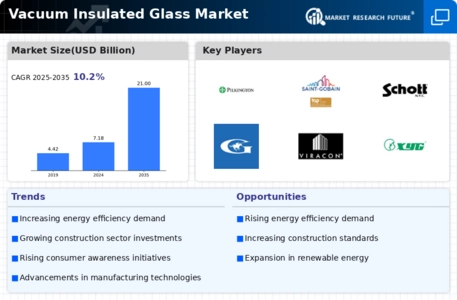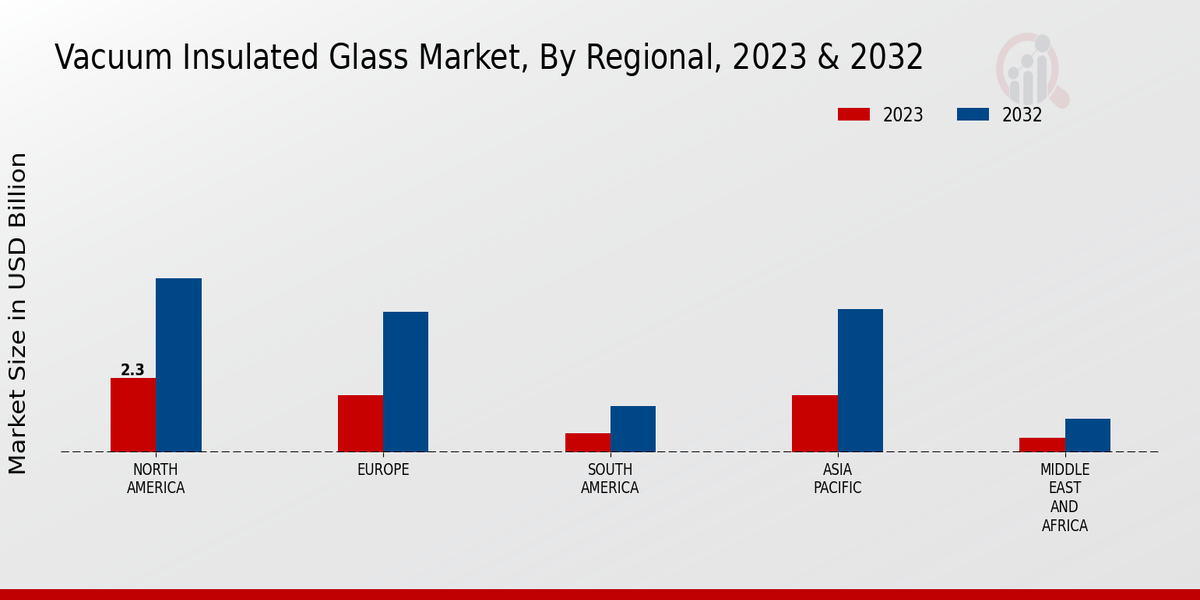Market Growth Projections
The Global Vacuum Insulated Glass Market Industry is poised for substantial growth, with projections indicating a market size of 7.18 USD Billion in 2024 and an anticipated increase to 21.0 USD Billion by 2035. This growth trajectory suggests a compound annual growth rate of 10.24% from 2025 to 2035, reflecting the increasing adoption of vacuum insulated glass across various sectors. The market dynamics are influenced by factors such as rising energy costs, technological advancements, and heightened awareness of sustainability. As these trends continue to evolve, the vacuum insulated glass market is likely to expand, presenting opportunities for manufacturers and stakeholders.
Rising Demand for Energy Efficiency
The Global Vacuum Insulated Glass Market Industry is experiencing a notable increase in demand driven by the growing emphasis on energy-efficient building solutions. As energy costs continue to rise, consumers and businesses alike are seeking innovative materials that enhance thermal insulation. Vacuum insulated glass, with its superior insulating properties, offers a compelling solution. In 2024, the market is projected to reach 7.18 USD Billion, reflecting a shift towards sustainable construction practices. This trend is likely to accelerate as regulations around energy efficiency become more stringent, further propelling the adoption of vacuum insulated glass in both residential and commercial sectors.
Diverse Applications Across Industries
The versatility of vacuum insulated glass is driving its adoption across a wide range of industries, thereby influencing the Global Vacuum Insulated Glass Market Industry. From residential buildings to commercial spaces and even automotive applications, vacuum insulated glass is being recognized for its superior thermal performance. This broad applicability not only enhances market potential but also encourages innovation in product development. As industries seek to improve energy efficiency and reduce operational costs, the demand for vacuum insulated glass is expected to grow. The market's expansion is indicative of the material's adaptability and its alignment with contemporary energy-saving initiatives.
Government Initiatives and Regulations
Government initiatives aimed at promoting energy efficiency and sustainability are playing a pivotal role in shaping the Global Vacuum Insulated Glass Market Industry. Various countries are implementing regulations that mandate the use of energy-efficient materials in construction projects. These policies not only encourage the adoption of vacuum insulated glass but also provide financial incentives for its use. As governments worldwide continue to prioritize environmental sustainability, the demand for vacuum insulated glass is expected to rise. This regulatory support is likely to contribute to the market's growth trajectory, reinforcing the importance of compliance with energy efficiency standards in the construction sector.
Technological Advancements in Manufacturing
Technological innovations in the production of vacuum insulated glass are significantly influencing the Global Vacuum Insulated Glass Market Industry. Advances in manufacturing techniques, such as improved sealing methods and the use of advanced materials, enhance the performance and durability of vacuum insulated glass products. These developments not only reduce production costs but also expand the range of applications for vacuum insulated glass, making it more accessible to various industries. As a result, the market is expected to grow substantially, with projections indicating a rise to 21.0 USD Billion by 2035. This growth underscores the importance of continuous innovation in maintaining competitive advantage.
Increasing Awareness of Sustainable Building Materials
The Global Vacuum Insulated Glass Market Industry is witnessing a surge in interest due to the increasing awareness of sustainable building materials. As environmental concerns gain prominence, architects and builders are prioritizing materials that contribute to reduced carbon footprints. Vacuum insulated glass, known for its energy-saving capabilities, aligns well with these sustainability goals. This heightened awareness is likely to drive market growth, as more stakeholders recognize the long-term benefits of investing in energy-efficient solutions. The anticipated compound annual growth rate of 10.24% from 2025 to 2035 indicates a robust future for vacuum insulated glass as a preferred choice in sustainable construction.



















